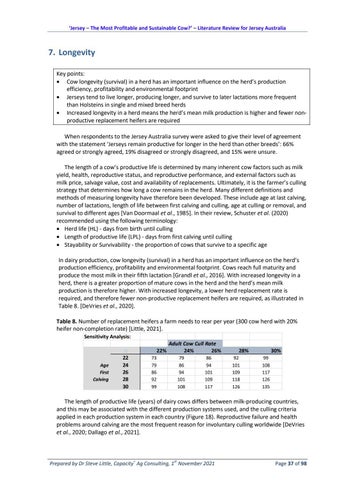‘Jersey – The Most Profitable and Sustainable Cow?’ – Literature Review for Jersey Australia
7. Longevity Key points: Cow longevity (survival) in a herd has an important influence on the herd’s production efficiency, profitability and environmental footprint Jerseys tend to live longer, producing longer, and survive to later lactations more frequent than Holsteins in single and mixed breed herds Increased longevity in a herd means the herd’s mean milk production is higher and fewer nonproductive replacement heifers are required When respondents to the Jersey Australia survey were asked to give their level of agreement with the statement ‘Jerseys remain productive for longer in the herd than other breeds’: 66% agreed or strongly agreed, 19% disagreed or strongly disagreed, and 15% were unsure. The length of a cow’s productive life is determined by many inherent cow factors such as milk yield, health, reproductive status, and reproductive performance, and external factors such as milk price, salvage value, cost and availability of replacements. Ultimately, it is the farmer’s culling strategy that determines how long a cow remains in the herd. Many different definitions and methods of measuring longevity have therefore been developed. These include age at last calving, number of lactations, length of life between first calving and culling, age at culling or removal, and survival to different ages [Van Doormaal et al., 1985]. In their review, Schuster et al. (2020) recommended using the following terminology: Herd life (HL) - days from birth until culling Length of productive life (LPL) - days from first calving until culling Stayability or Survivability - the proportion of cows that survive to a specific age In dairy production, cow longevity (survival) in a herd has an important influence on the herd’s production efficiency, profitability and environmental footprint. Cows reach full maturity and produce the most milk in their fifth lactation [Grandl et al., 2016]. With increased longevity in a herd, there is a greater proportion of mature cows in the herd and the herd’s mean milk production is therefore higher. With increased longevity, a lower herd replacement rate is required, and therefore fewer non-productive replacement heifers are required, as illustrated in Table 8. [DeVries et al., 2020]. Table 8. Number of replacement heifers a farm needs to rear per year (300 cow herd with 20% heifer non-completion rate) [Little, 2021]. Sensitivity Analysis: 22%
72
Age First Calving
22 24 26 28 30
Adult Cow Cull Rate 24% 26%
73 79 86 92 99
79 86 94 101 108
86 94 101 109 117
28% 92 101 109 118 126
30% 99 108 117 126 135
The length of productive life (years) of dairy cows differs between milk-producing countries, and this may be associated with the different production systems used, and the culling criteria applied in each production system in each country (Figure 18). Reproductive failure and health problems around calving are the most frequent reason for involuntary culling worldwide [DeVries et al., 2020; Dallago et al., 2021].
+
st
Prepared by Dr Steve Little, Capacity Ag Consulting, 1 November 2021
Page 37 of 98






















